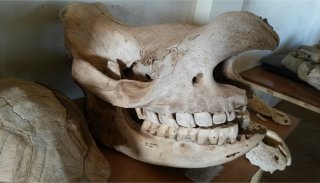
Research data was collected from Kenyan national parks over the past 60 years, combined with traits of the teeth of herbivorous mammals.
In the new study, the annual rainfall and average temperatures in the national parks are inferred from the teeth of herbivorous mammals. Such reverse engineering opens up new opportunities for interpreting fossil records. The results were recently published in the journal PNAS.
Exact data on the number and geographical spread of the animals in Kenya’s national parks have been collected over the course of the past 60 years. The data used for the modelling in this study include the mammals in Kenya's 13 national parks, dental traits, and rainfall, temperature and the amount of vegetation.
“We computed the average dental traits for each area and related them in relation to environmental factors using regression models. The model’s generalizability was tested, and the predictability of individual environmental factors was compared,” explains researcher Indrė Žliobaitė, who was responsible for the modelling.
The research shows that features in animal teeth are particularly good at detecting where the weather has been unfavorable for the species in question. Such weather conditions include long dry periods, heavy rains or exceptionally low temperatures – anything that could result in the animal’s primary food source becoming unavailable, forcing the animals to turn to less preferred plants to survive.
The researchers were particularly interested in why animals were absent from a particular geographical area.
“African national parks frequently endure poor years, which seem to prevent the establishment of permanent populations of certain animals. Animals live where the conditions allow them to live and reproduce over the span of decades or centuries,” says Mikael Fortelius, professor of evolutionary paleontology at the University of Helsinki.
“We would be able to go millions of years past and see what the weather conditions were like back then, and that we have actually done in another research article published earlier this year in The Royal Society Publishing including the temperature curves of the past millions of years”, adds Žliobaitė.
The role of a computer scientist in studies like this is to deal with high-dimensional datasets and make the estimates, as evolutionary paleontologists make the analysis and interpretations based on the estimates. This work follows the collaboration between professor of evolutionary paleontology Mikael Fortelius in the University of Helsinki and professor Heikki Mannila from the Aalto University Department of Computer Science, now the President of the Academy of Finland, started about 10 years ago.
PNAS.org: Herbivore teeth predict climatic limits in Kenyan ecosystems: Indrė Žliobaitė, Janne Rinne, Anikó B. Tóth, Michael Mechenich, Liping Liu, Anna K. Behrensmeyer and Mikael Fortelius
The Royal Society Publishing: An ecometric analysis of the fossil mammal record of the Turkana Basin: Mikael Fortelius, Indrė Žliobaitė, Ferhat Kaya, Faysal Bibi, René Bobe, Louise Leakey, Meave Leakey, David Patterson, Janina Rannikko and Lars Werdelin
Further information:
Indrė Žliobaitė
Researcher
Department of Computer Science and HIIT, Aalto University
Department of Geosciences and Geography, University of Helsinki
indre.zliobaite@aalto.fi
Mikael Fortelius
Professor of Evolutionary Paleontology
Department of Geosciences and Geography
University of Helsinki
mikael.fortelius@helsinki.fi
Contact person: Indrė Žliobaitė
Last updated on 15 Nov 2016 by Noora Suominen de Rios - Page created on 4 Nov 2016 by Noora Suominen de Rios